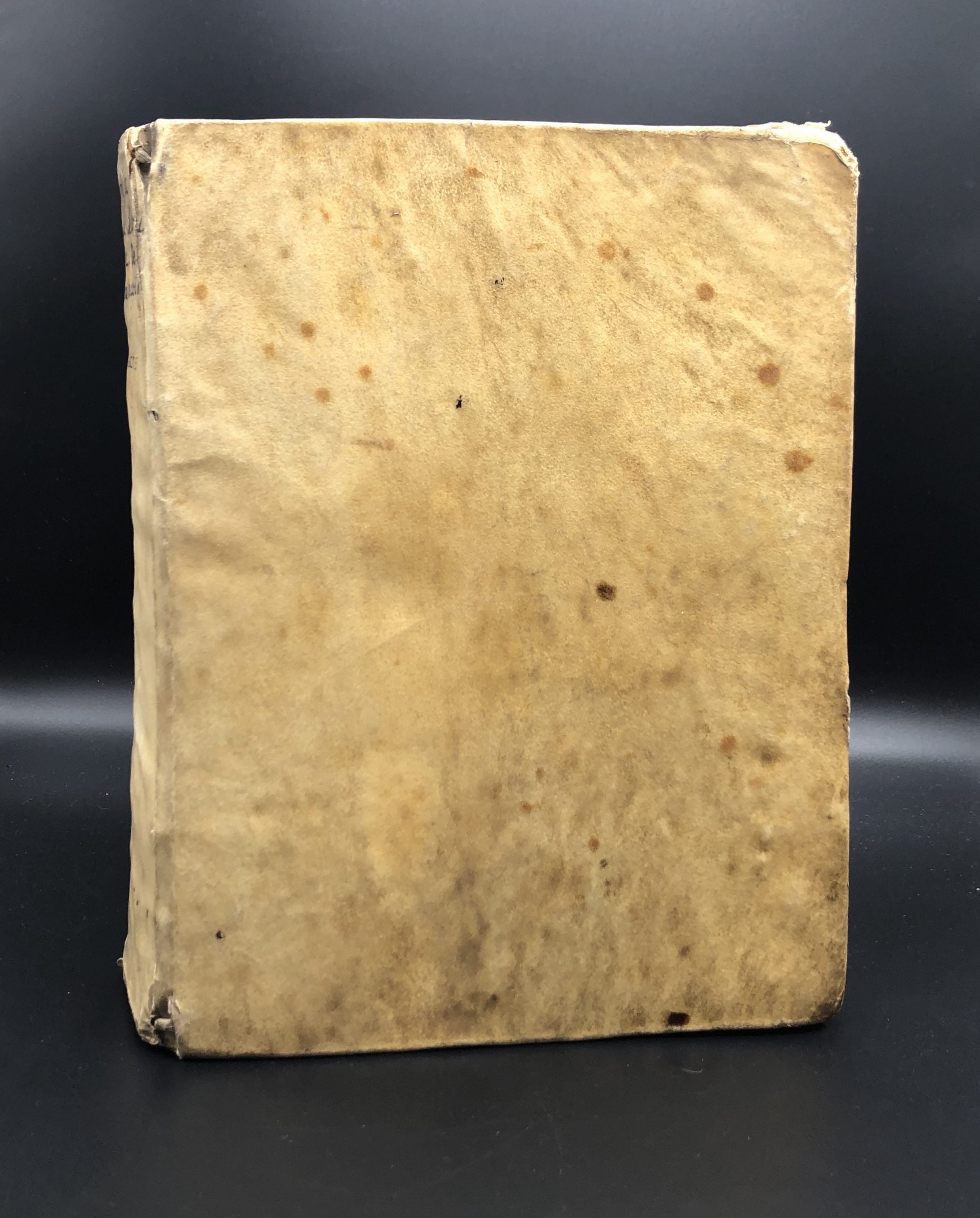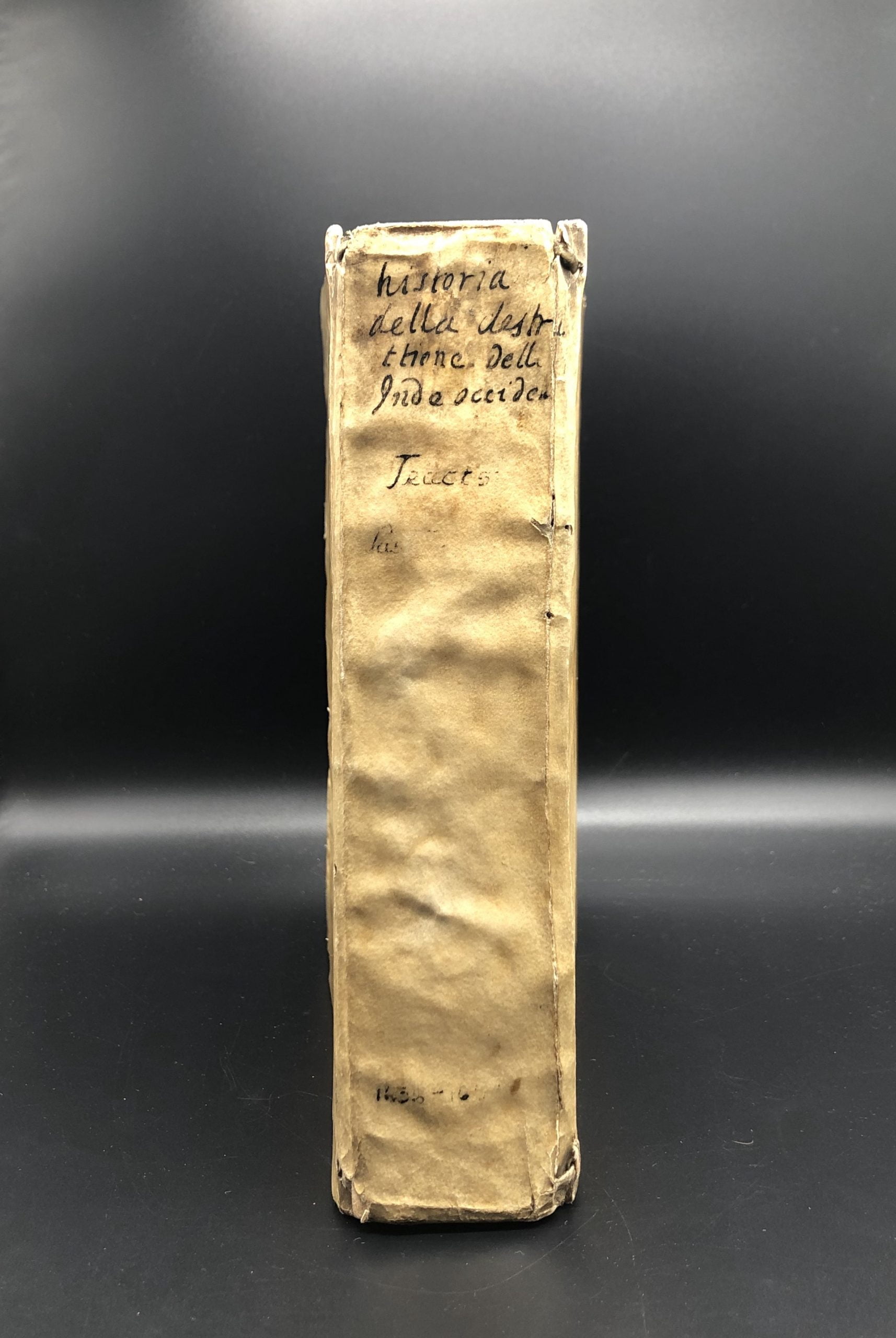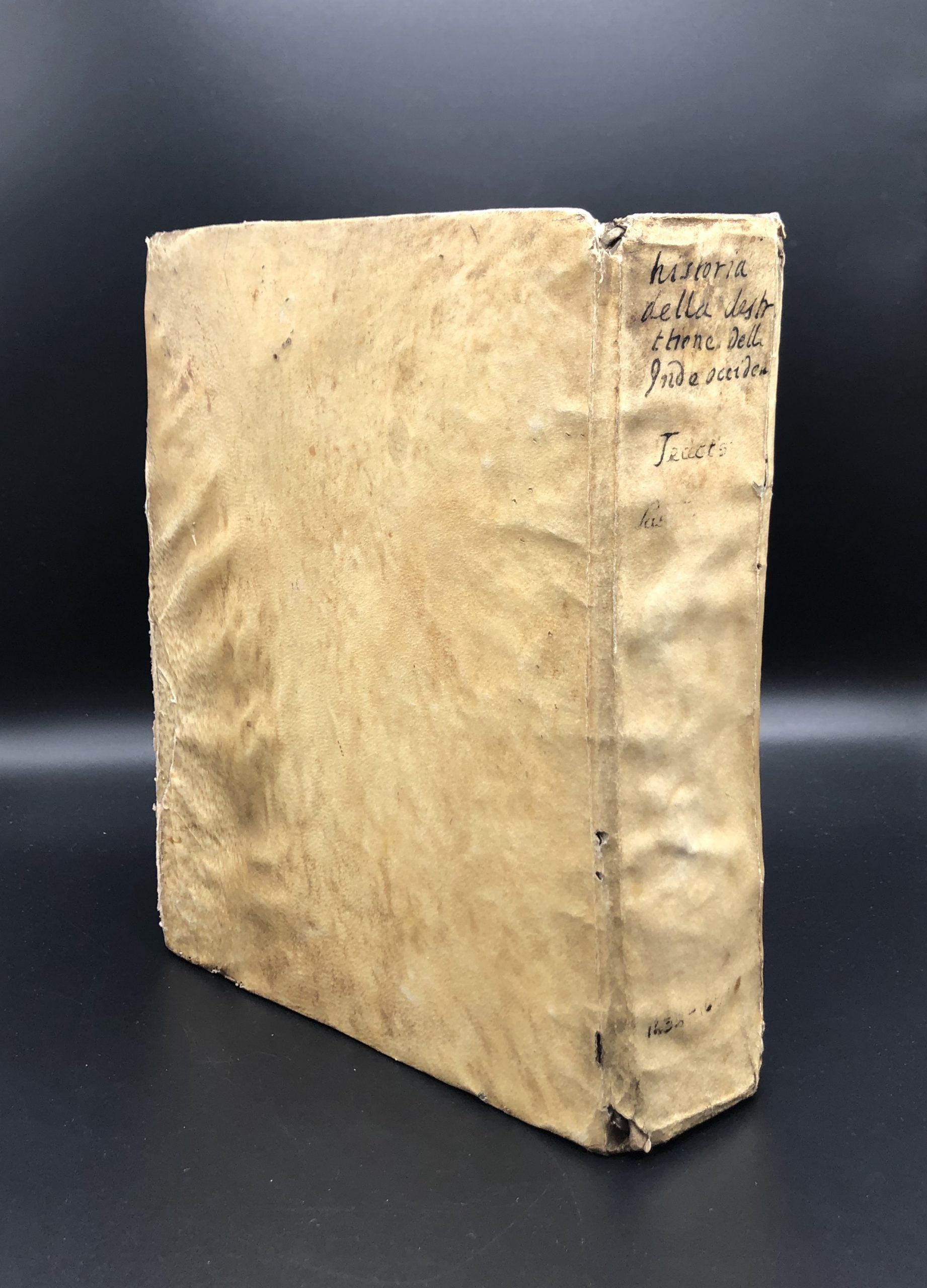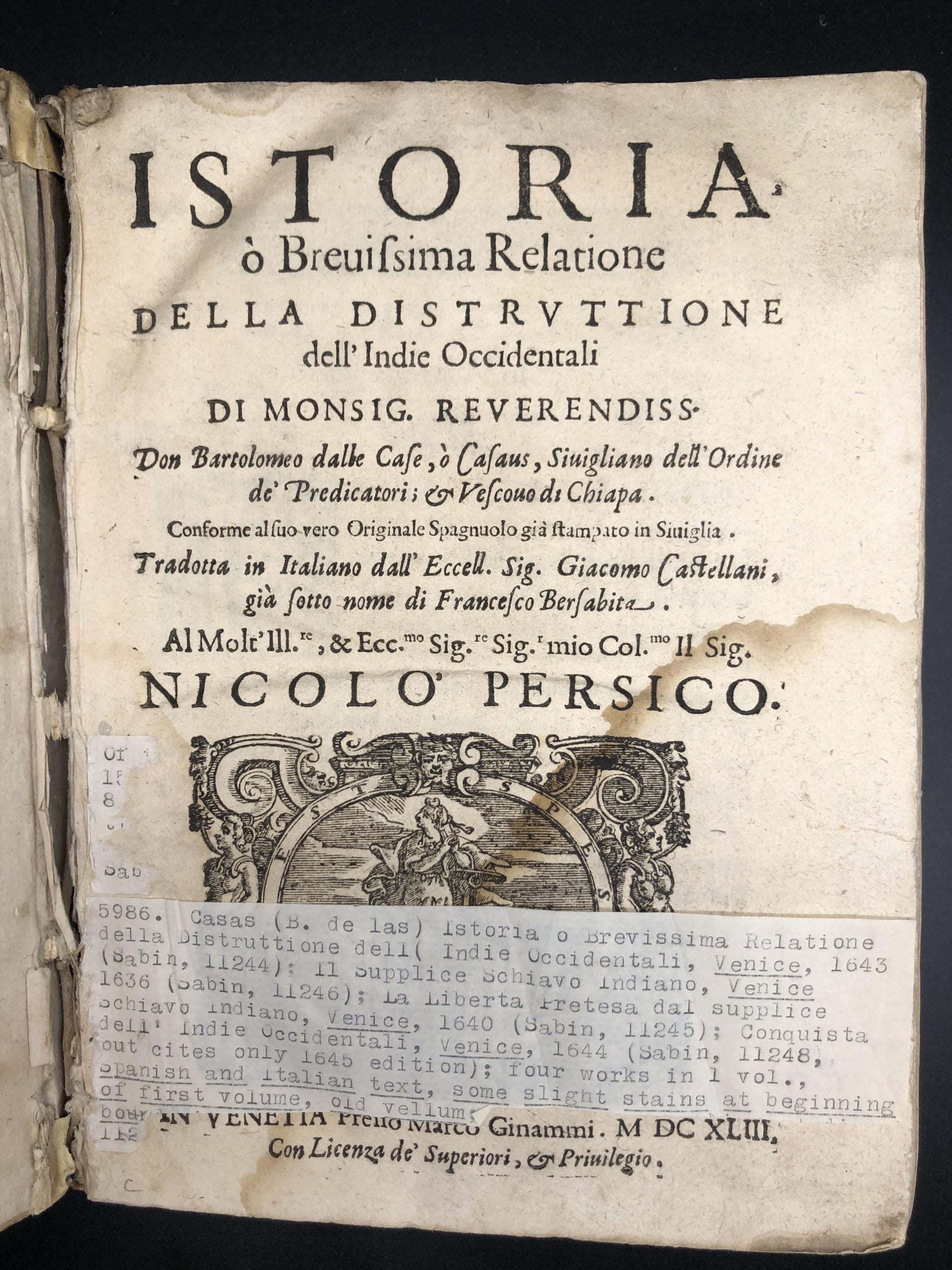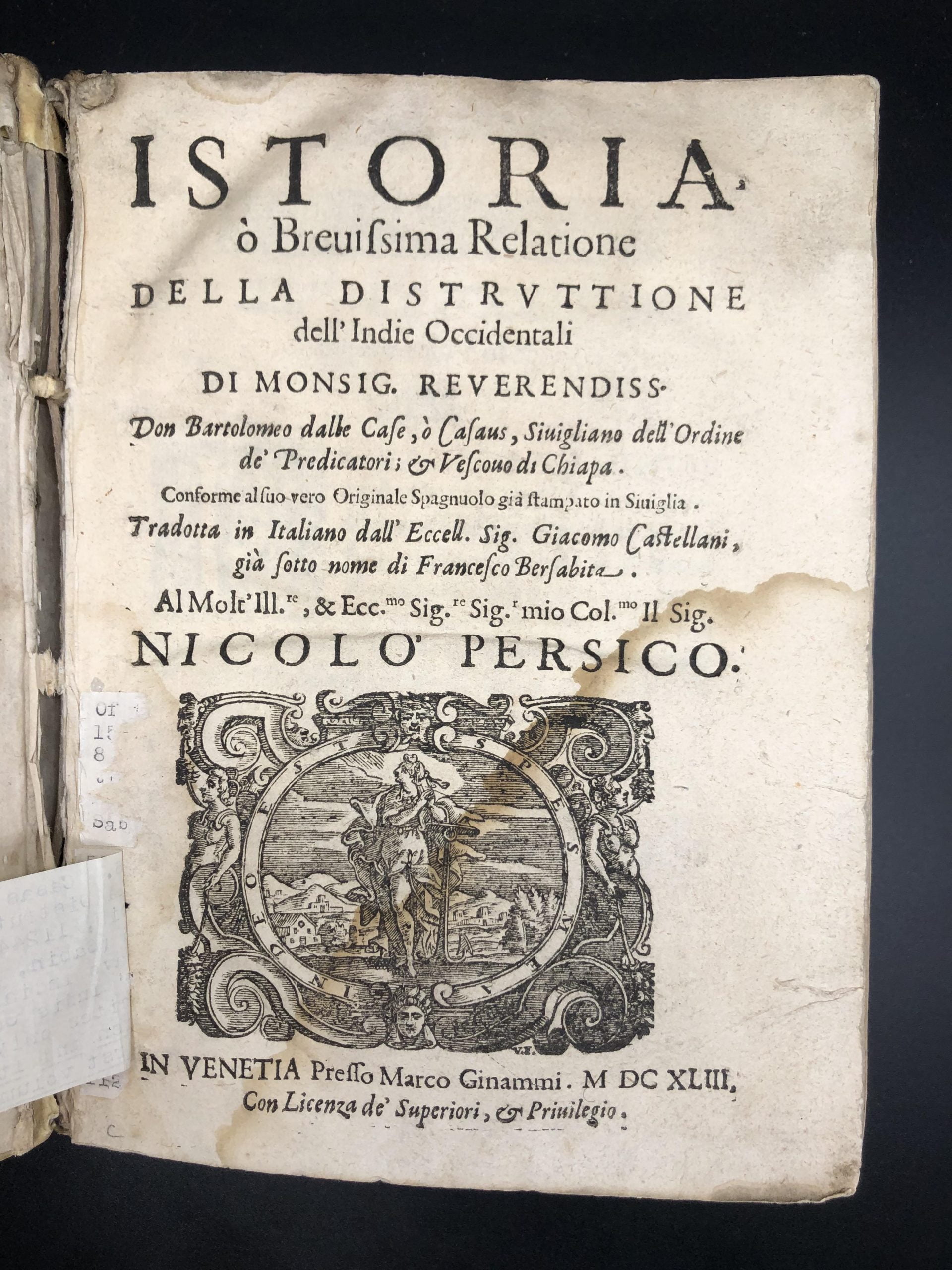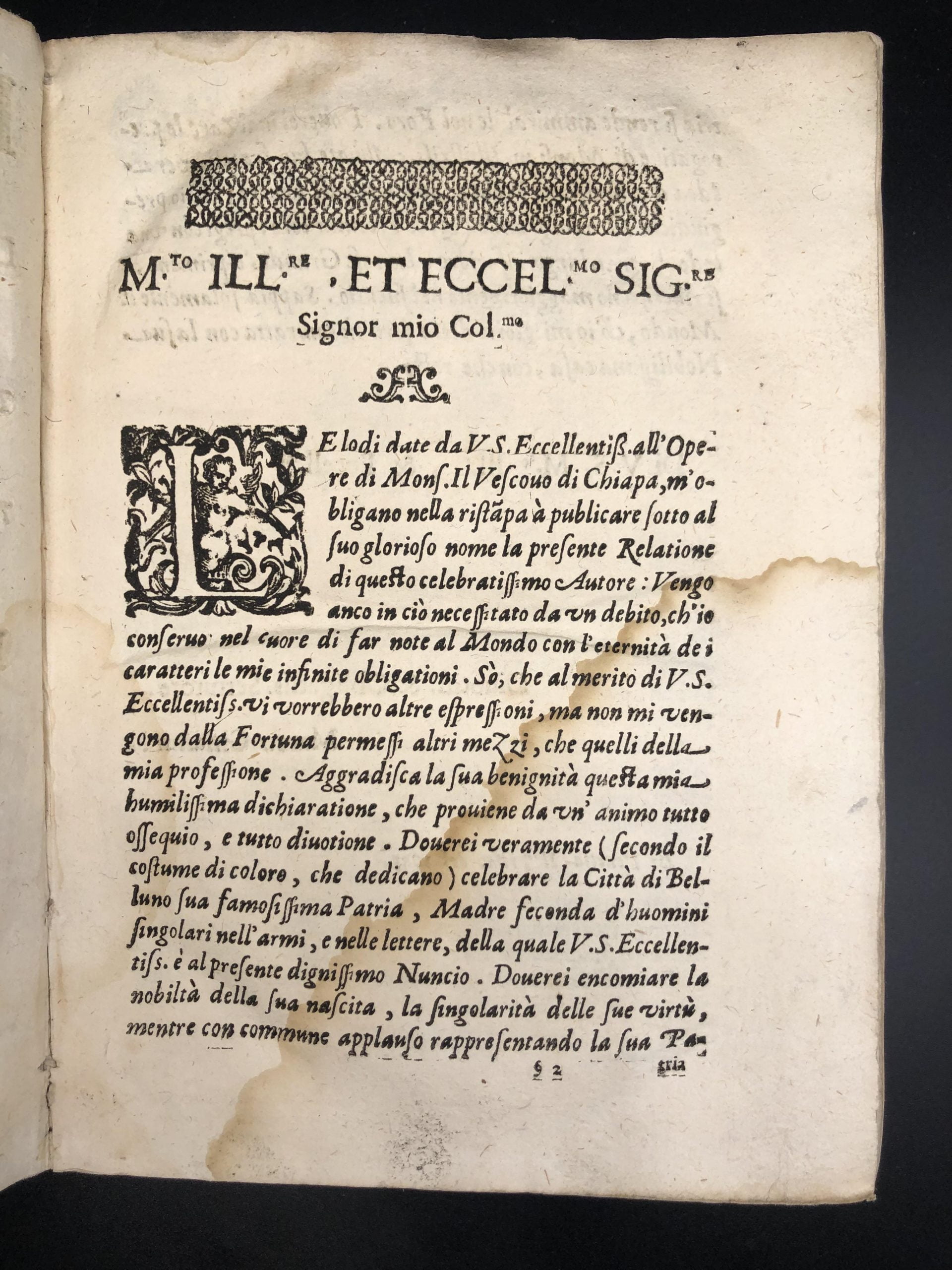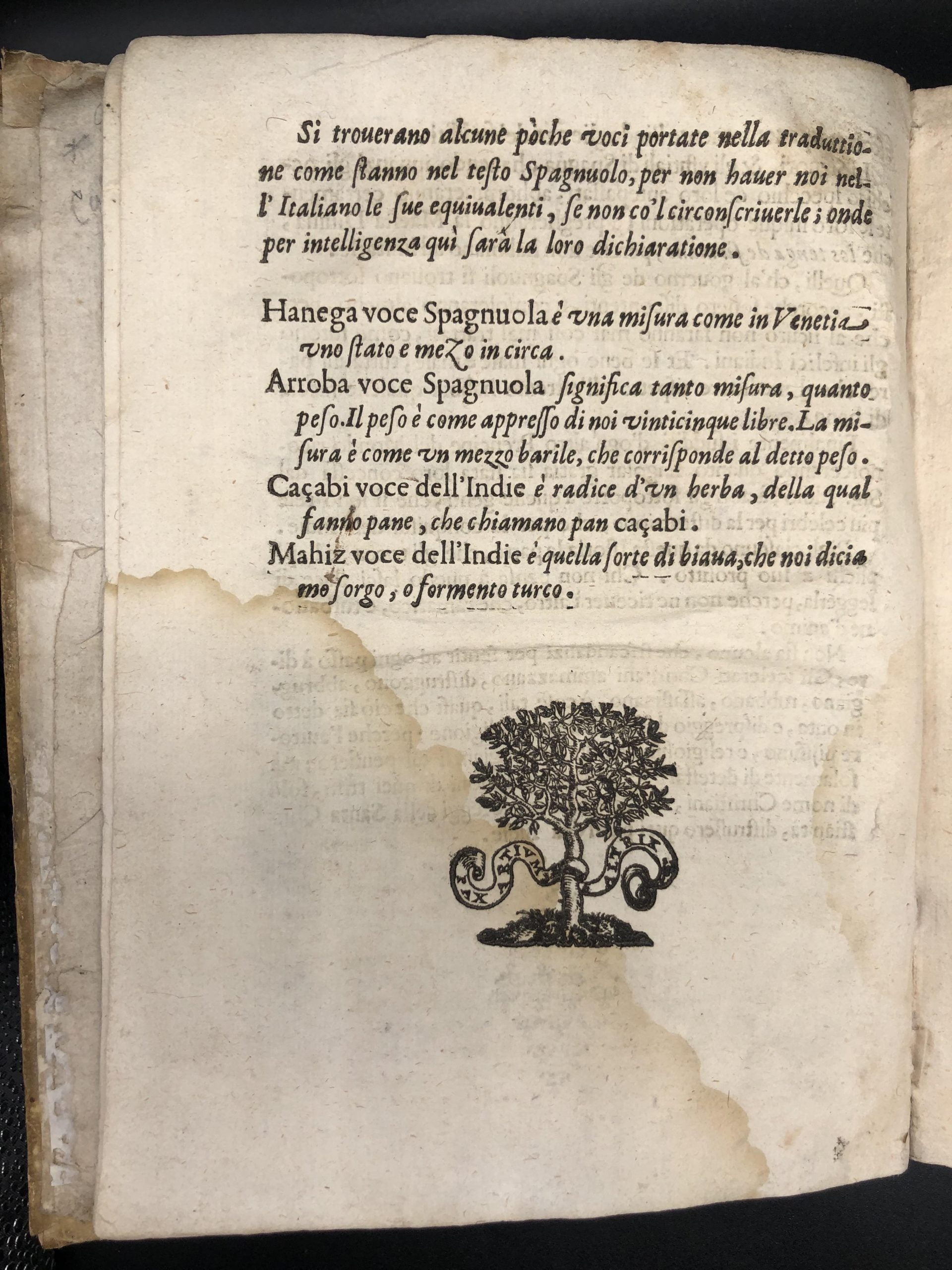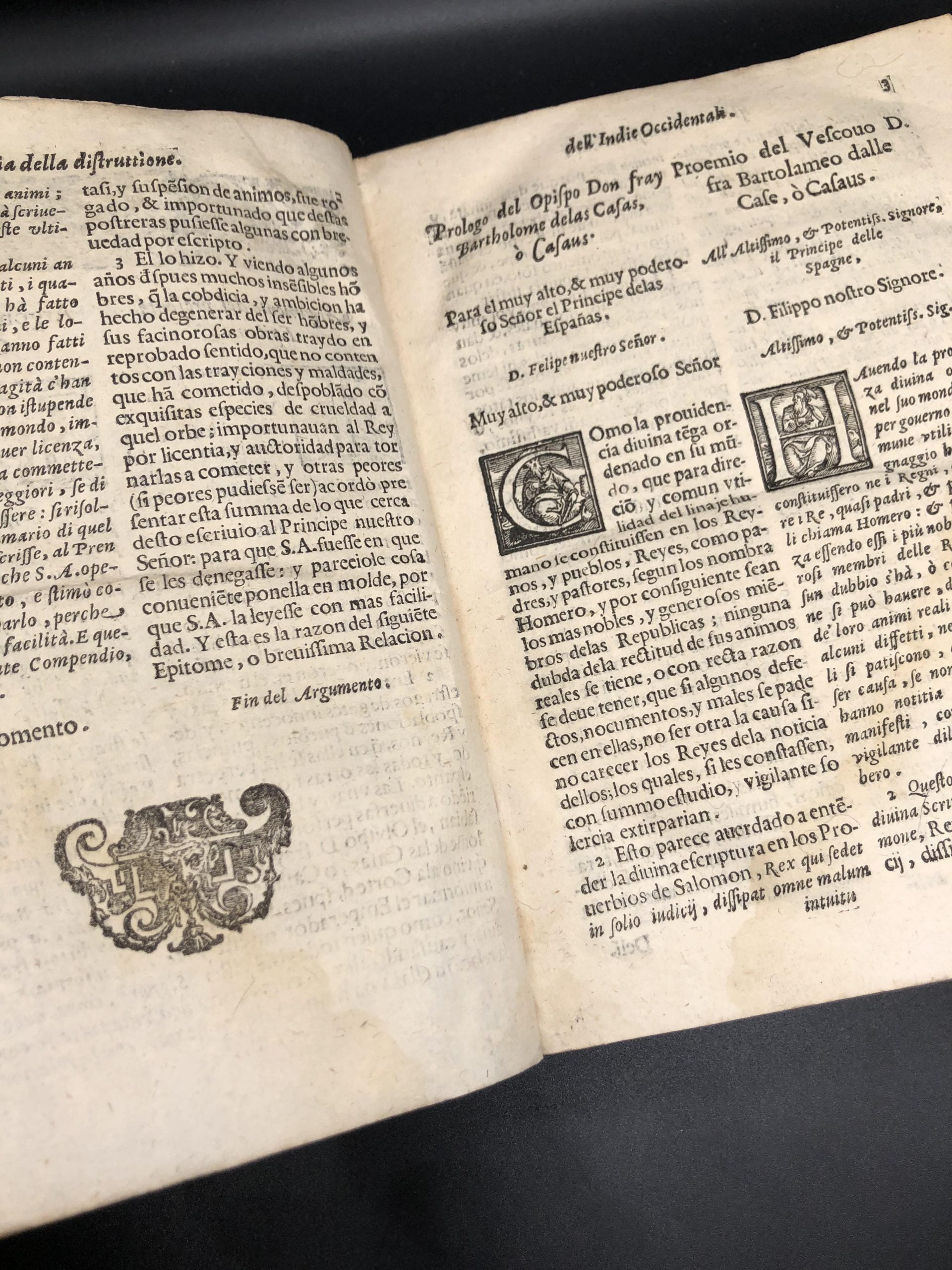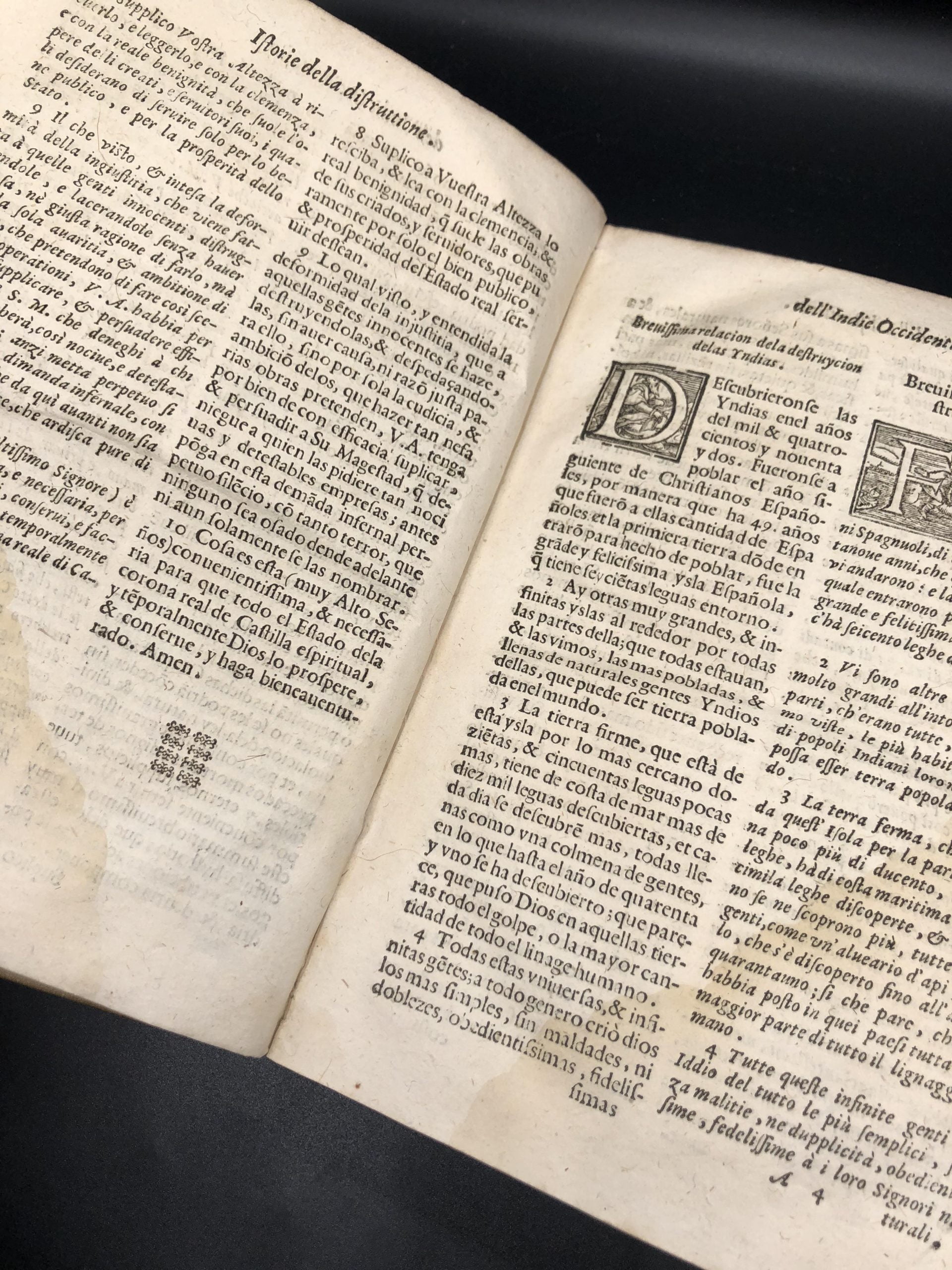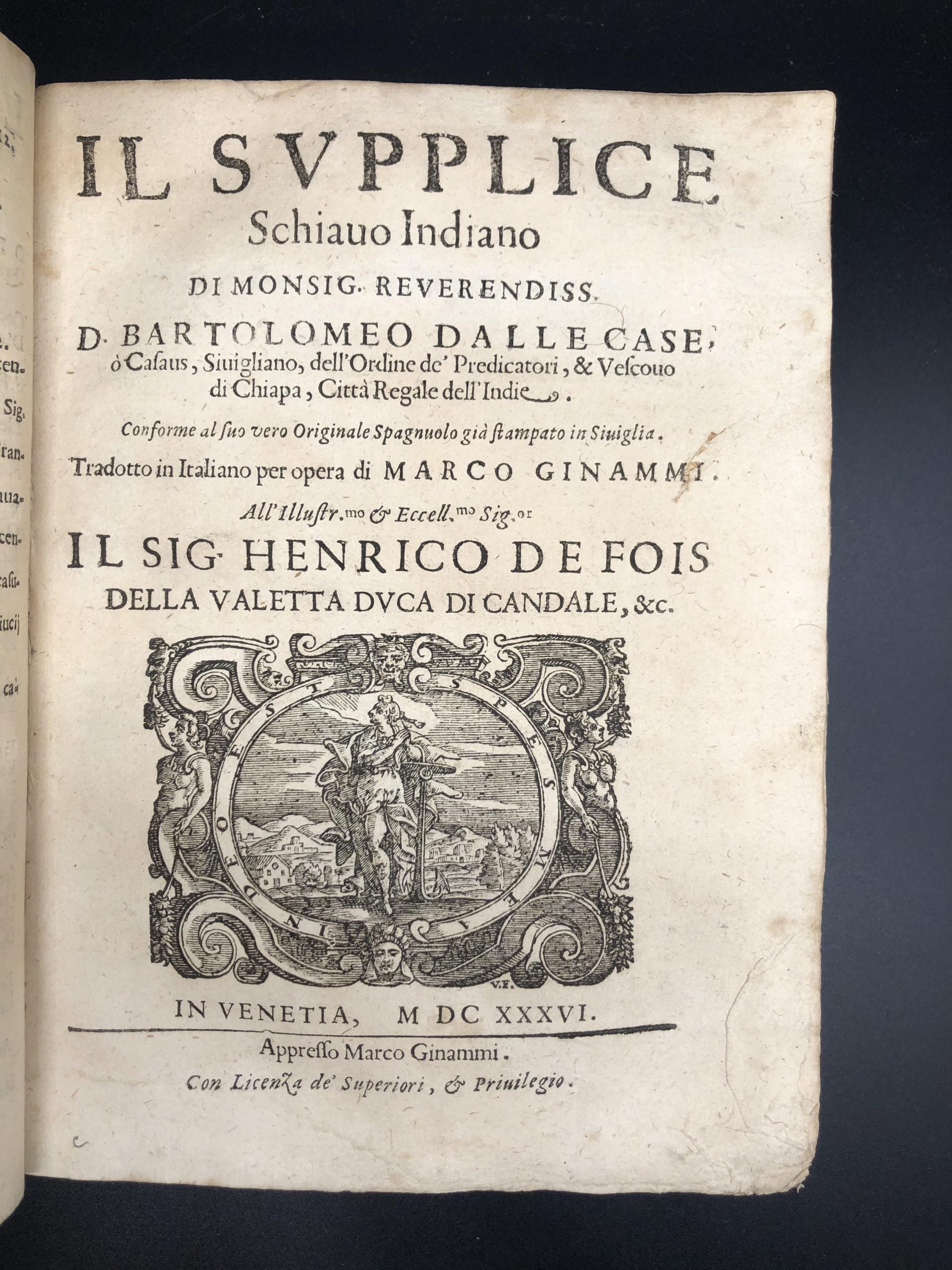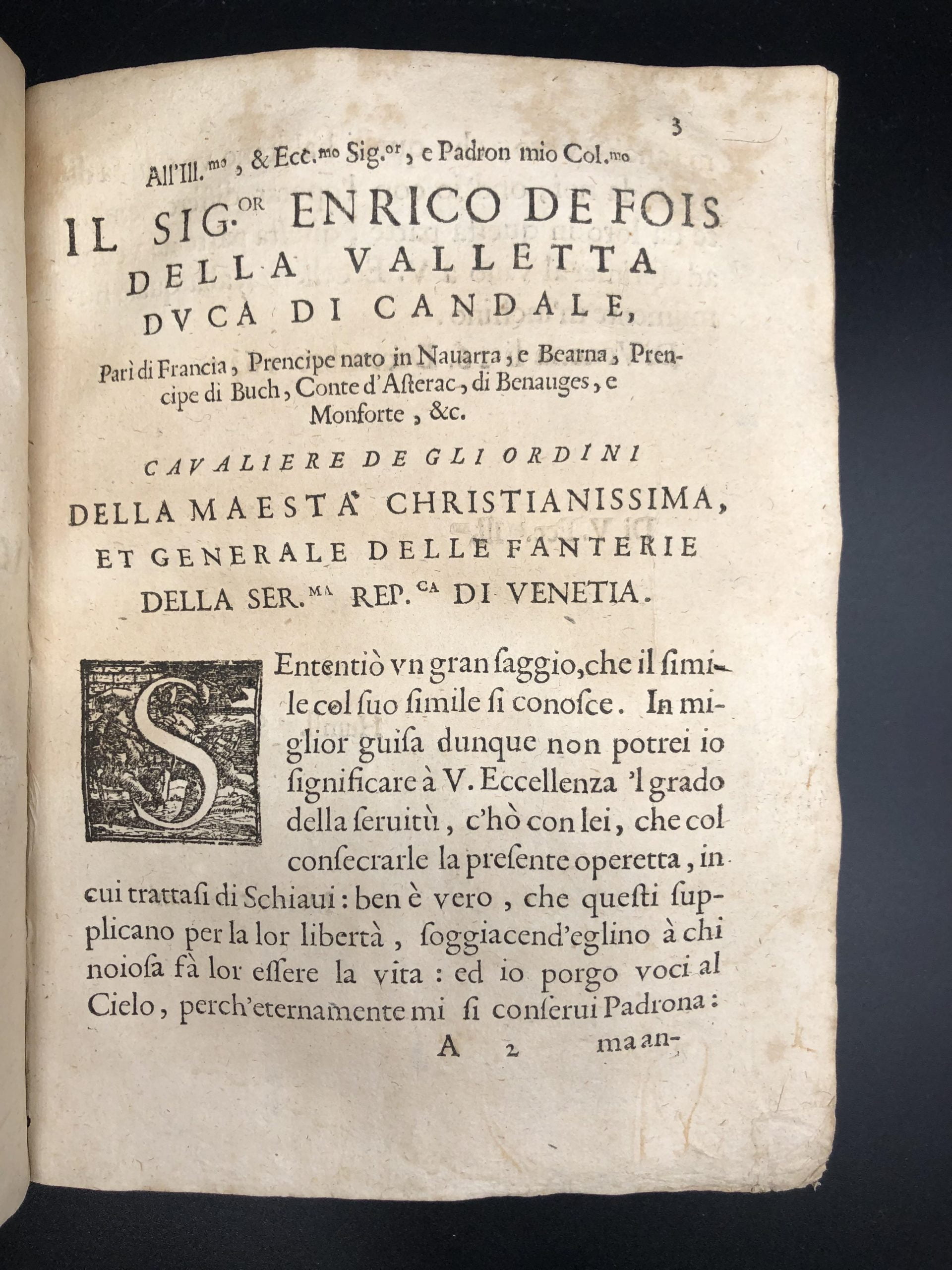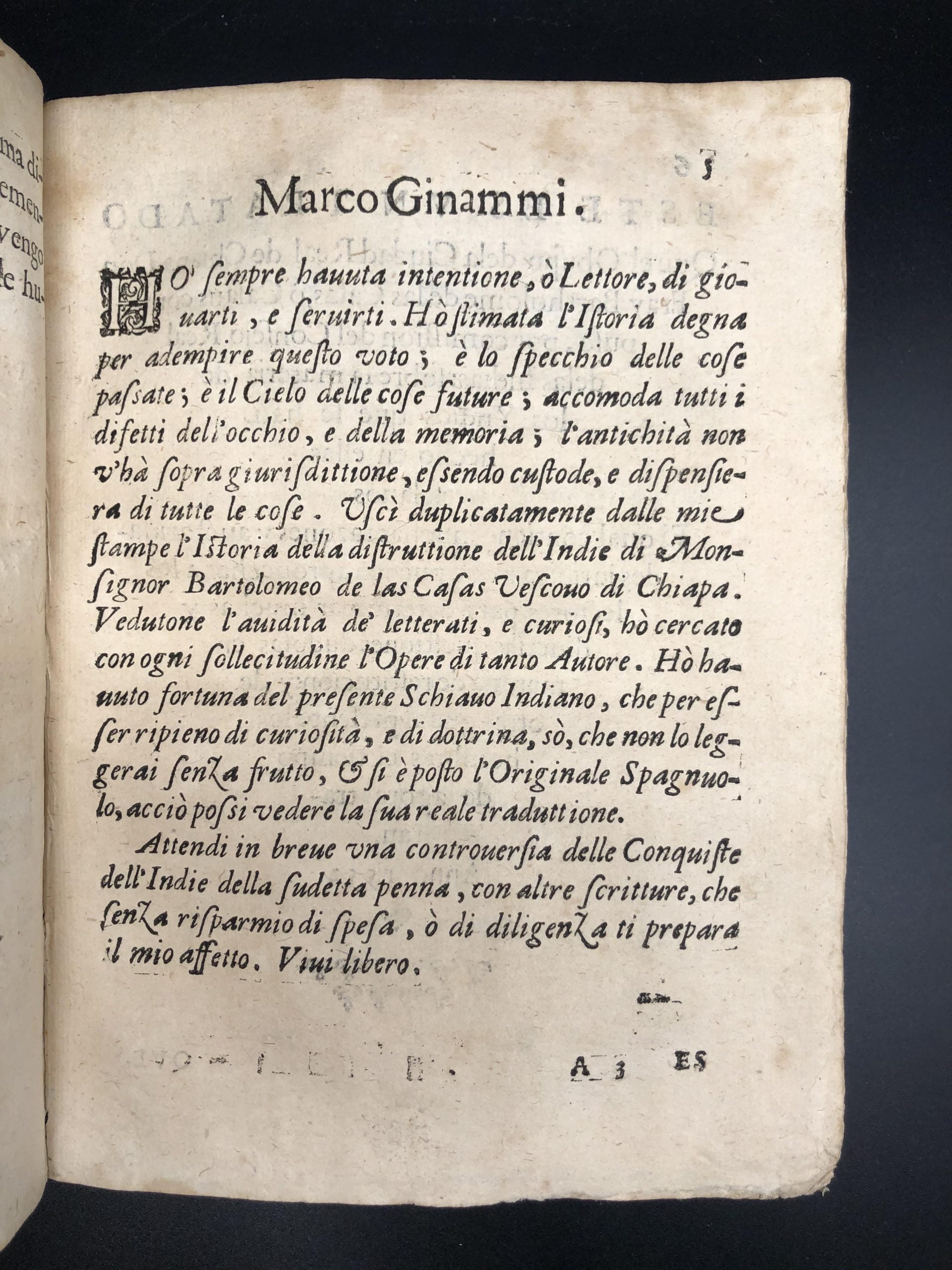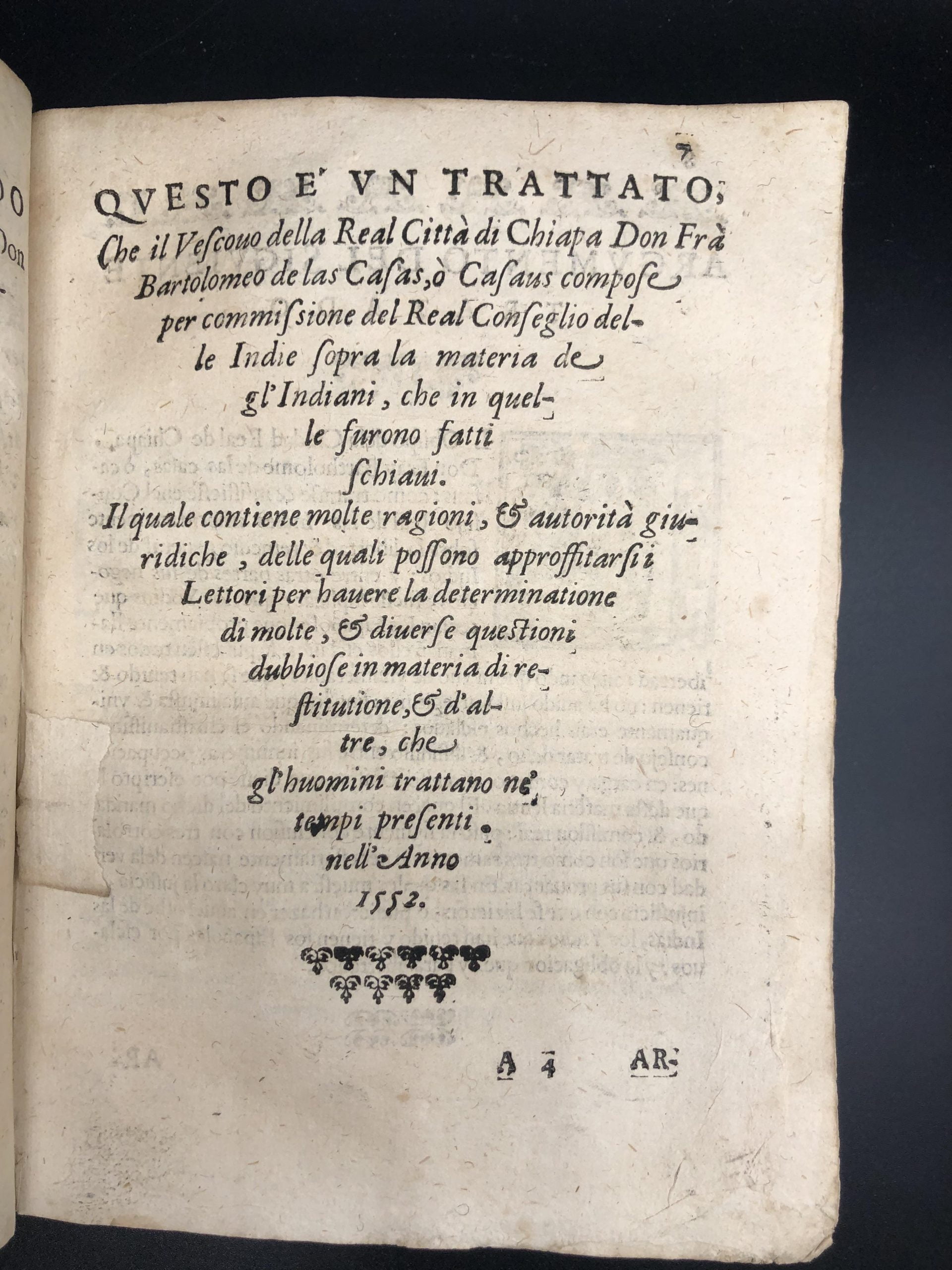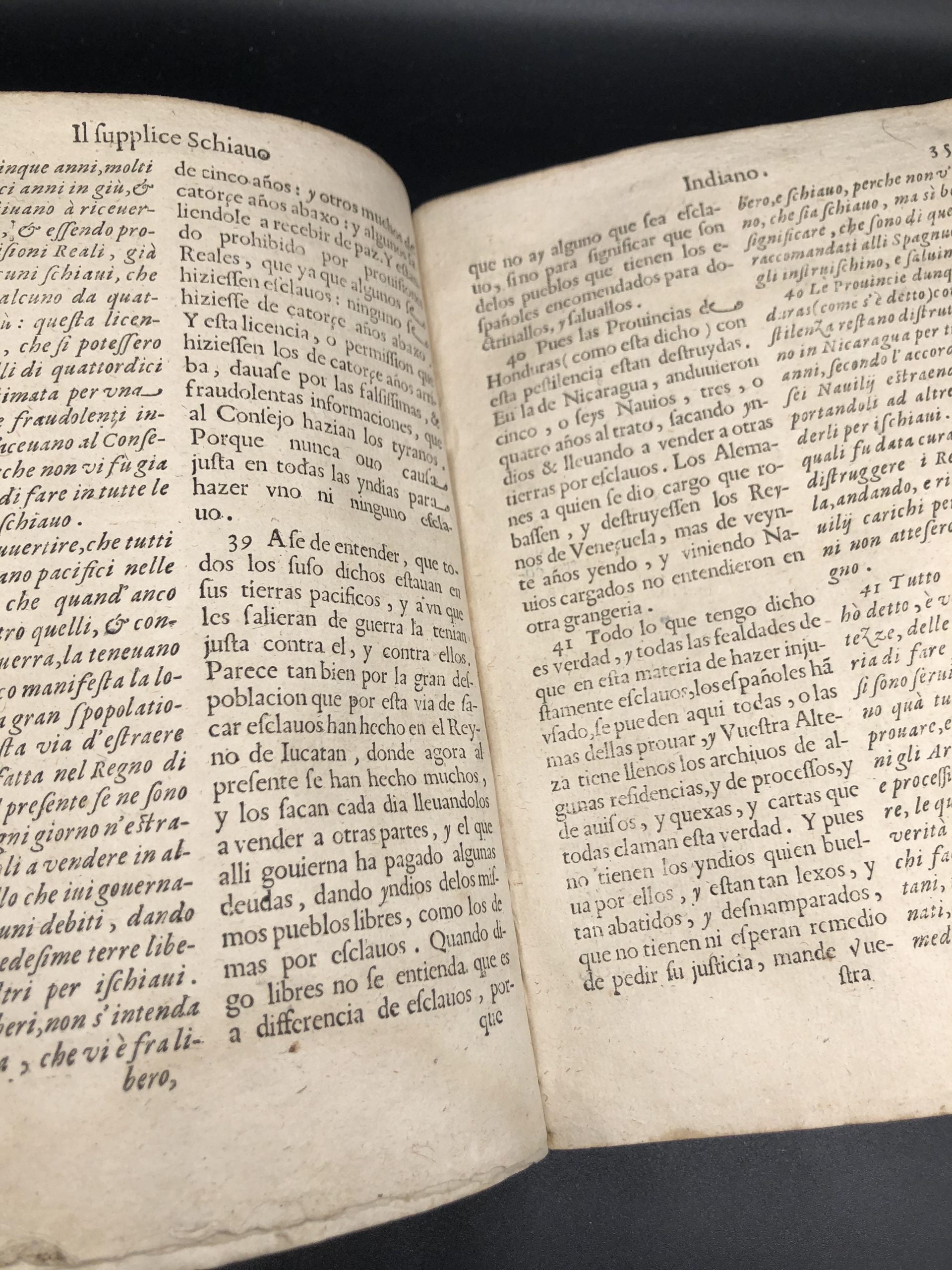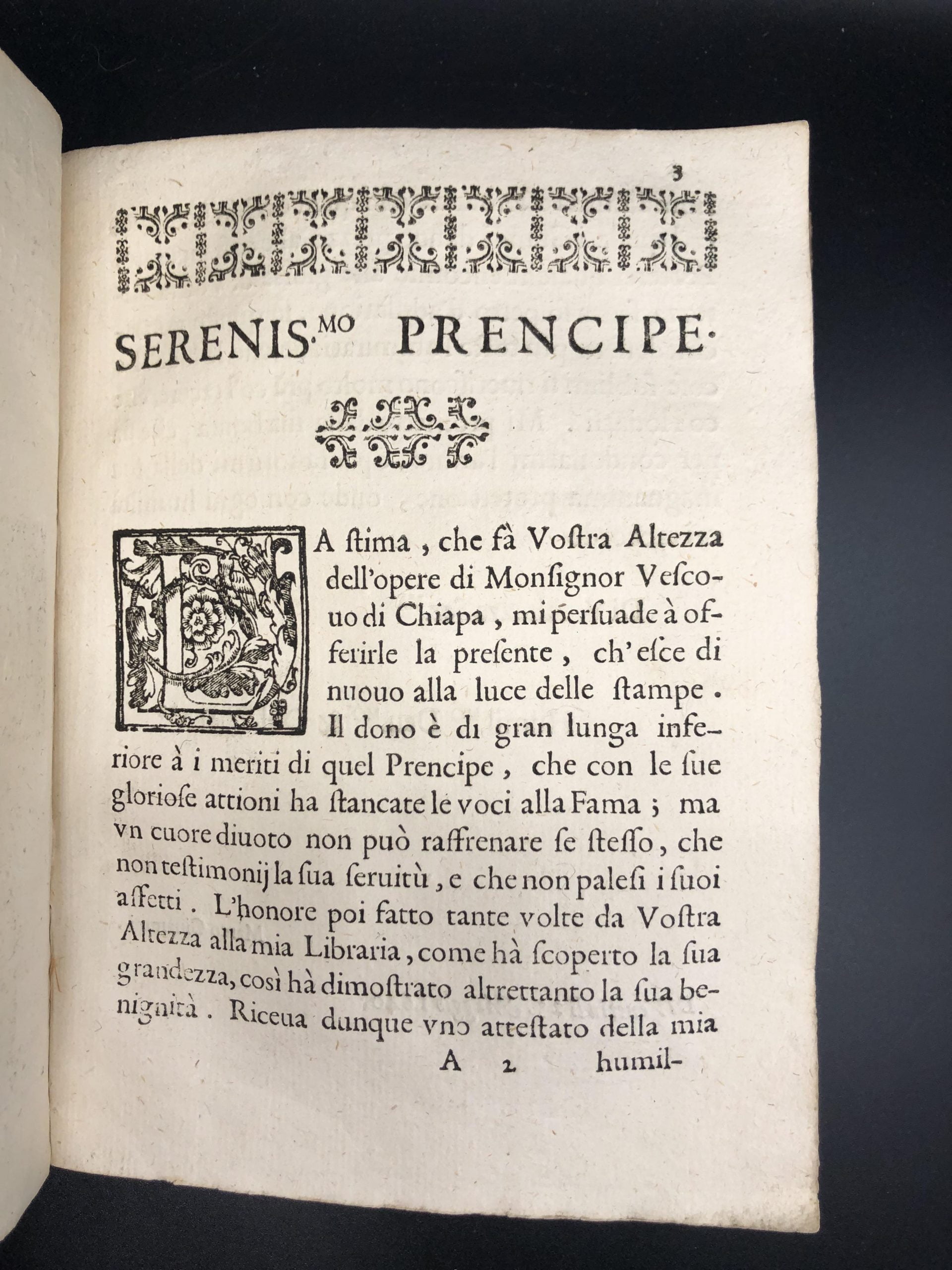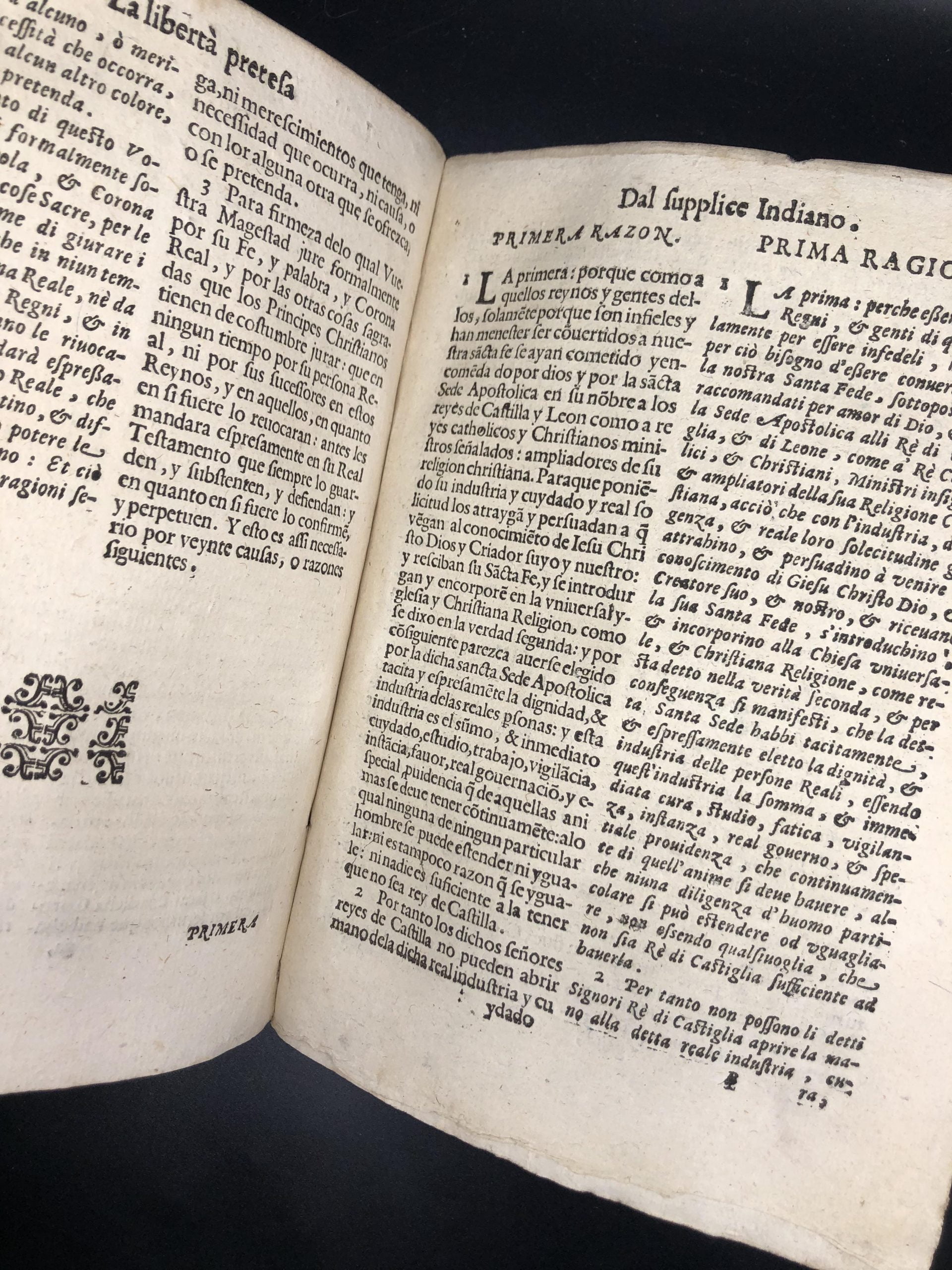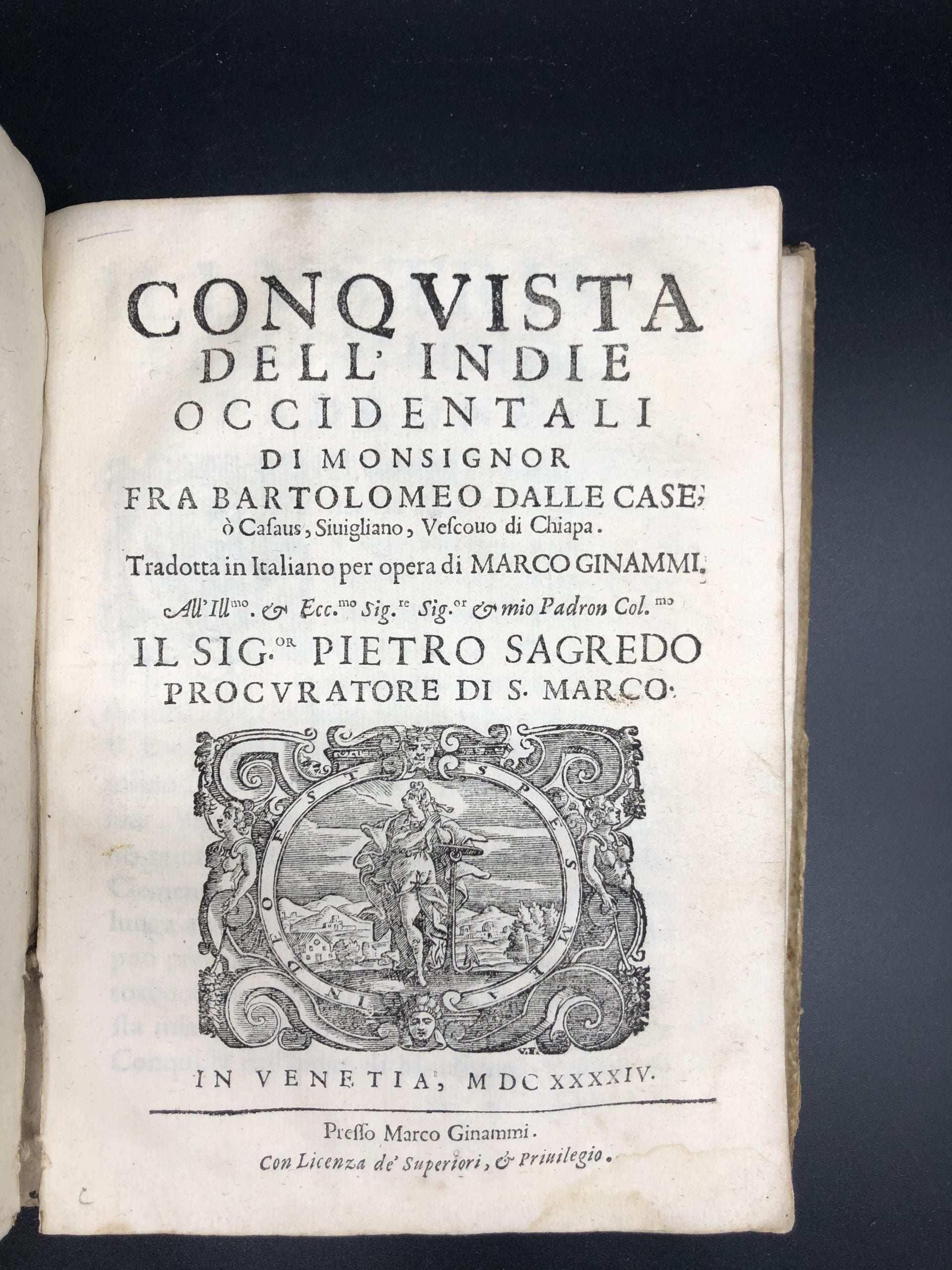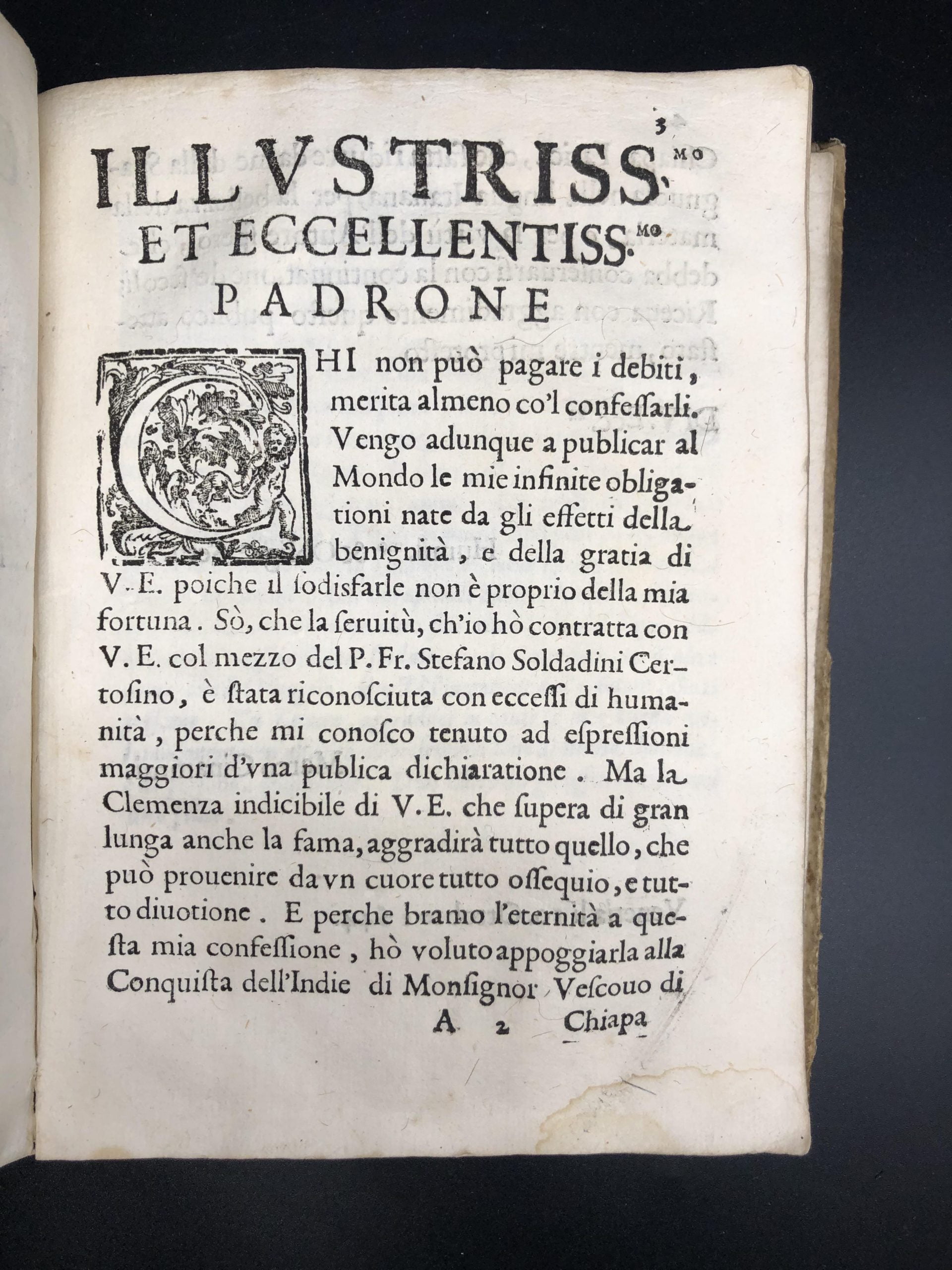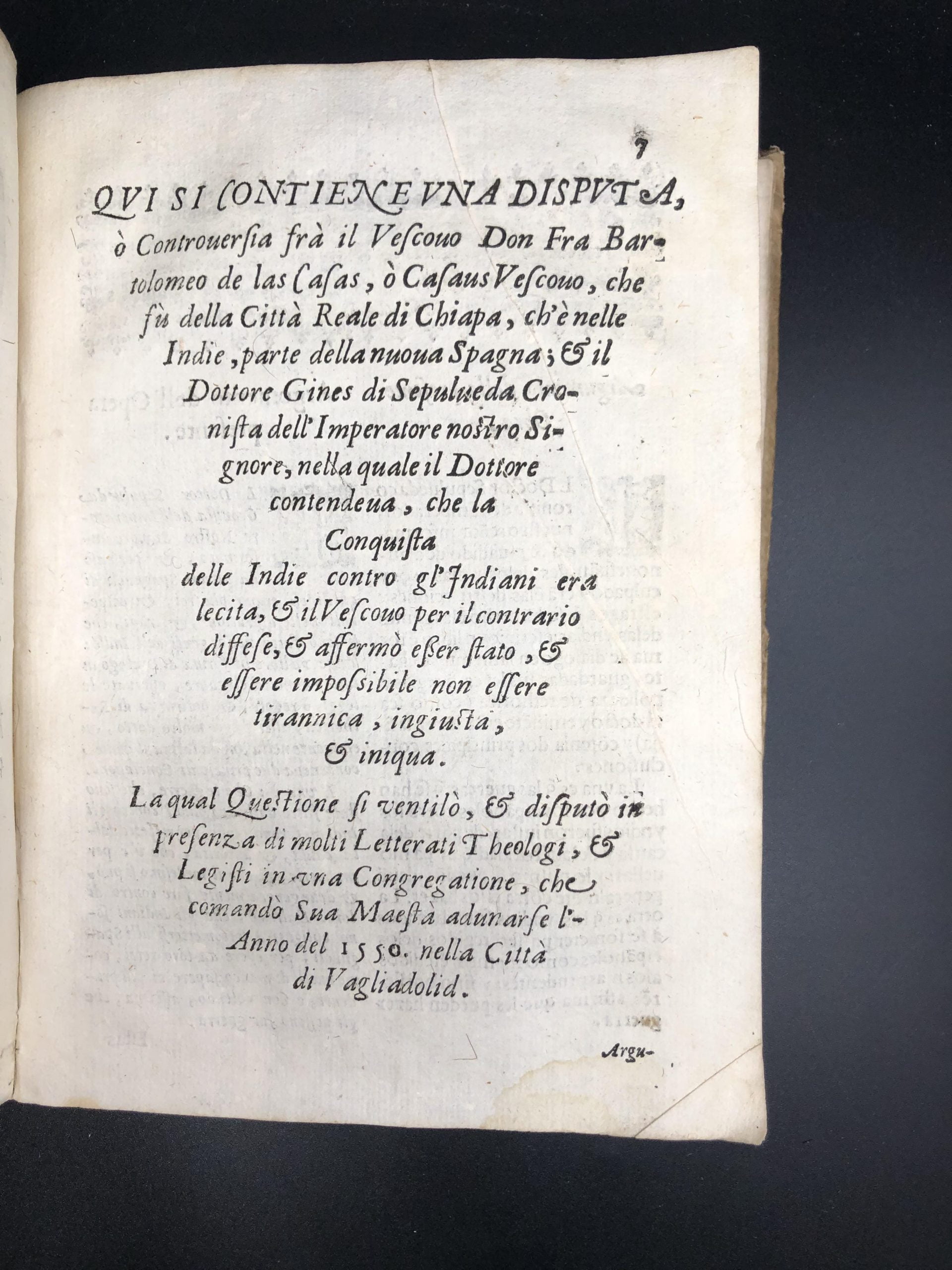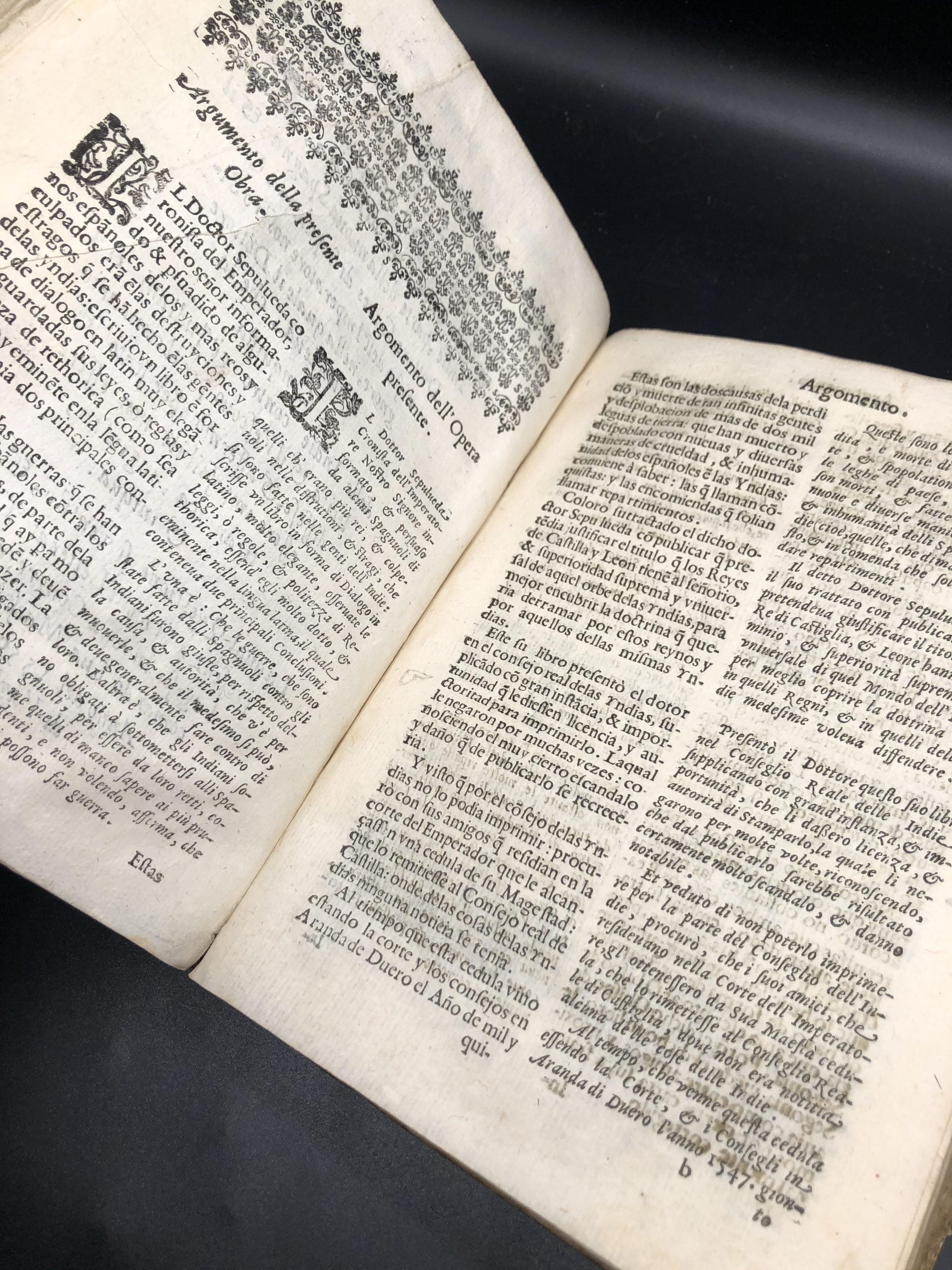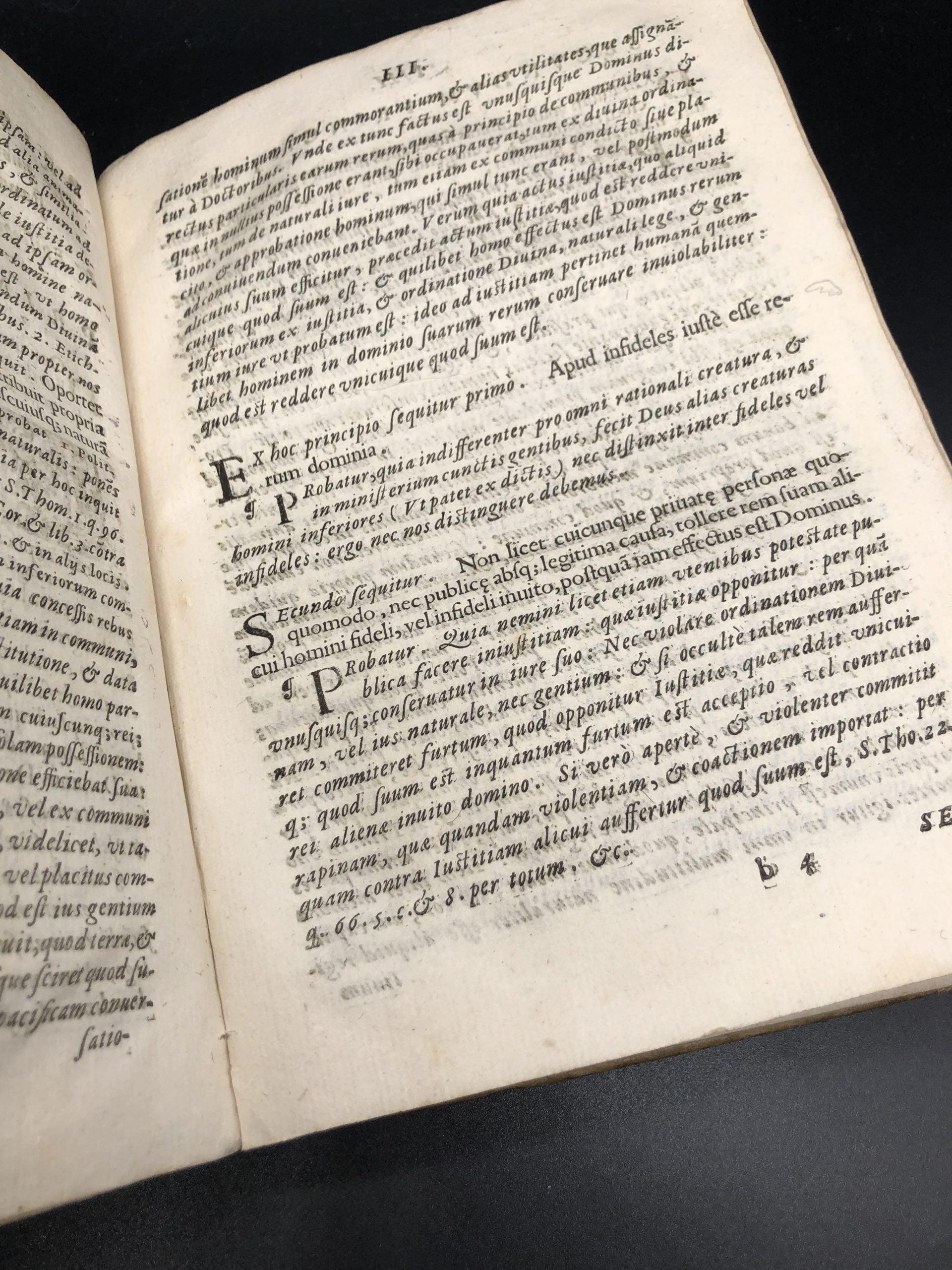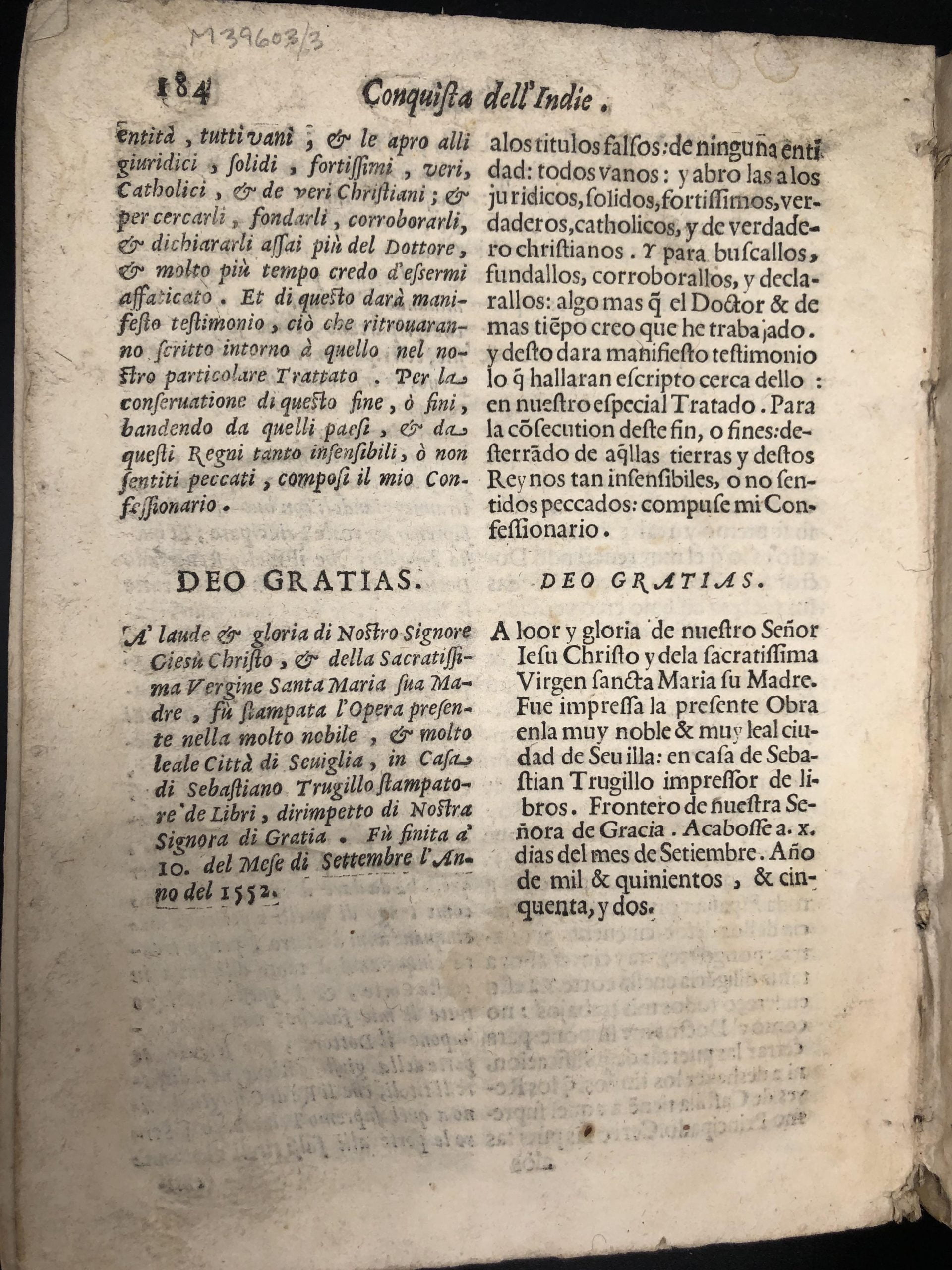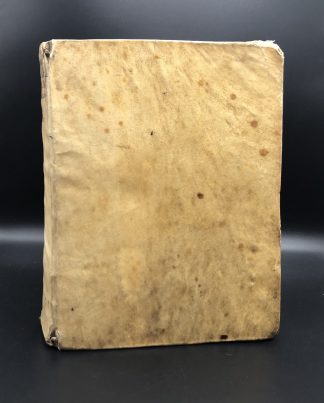CASAS, Bartolomé de las
SAMMELBAND OF AMERICANA
Istoria o Breuissima relatione della distruttione dell\\\'Indie Occidentali; (2) Il supplice schiavo indiano; (3) La libertà pretesa dal supplice schiavo indiano; (4) Conquista delle Indie Occidentali
Venice, Marco Ginammi, 1643; (2) 1636; (3) 1640; (4) 1644£5,650.00
FIRST EDITION thus of second and fourth. Small 4to, 4 works in 1, separate t-ps, pp. (viii) 150 (ii); 118 (ii); 155 (v); 184. Roman letter, with Italic, double column with parallel Spanish and Italian text. Woodcut printer’s device to t-ps, decorated initials and ornaments. Slight browning, most lower and a few outer edges of vols. II-III uncut, I: t-p a little dusty, C20 bibliographic paper slip glued at gutter, light water stain to lower outer quarter of first two gatherings, IV: very slight water stain to lower outer blank corner of first few ll., small tear to lower outer blank corner of b5 and E5, verso of last a little dusty. Very good, generally clean copies in C17 vellum, extremities a bit rubbed (unobtrusive repair to lower cover from edge), upper hinge starting but firm. C17 engraved armorial bookplate of James Hamilton, 3rd Marquess and 1st Duke of Hamilton, to front pastedown.
A most interesting sammelband of Americana, with four works on the conquest of the New World, in the Italian translation with the original Spanish. Crucial are the prefaces and letters to the reader by Marco Gimanni—printer of all four and translator of three—which shed light on the understanding of the Spanish conquests. Bartolomé de las Casas (1484-1566) was among the most influential figures in the definition of juridical and social principles for the Spanish colonisation of the Americas. One of the earliest settlers, he freed his native slaves in 1515, later defending their rights in front of the Emperor Charles V. In the 1520s, he joined the Dominican order and acted as a missionary for several years. He was the first to be appointed to the office of ‘Protector of the Indios’, responsible for the well-being of the natives in the colonies. ‘Istoria’ first appeared, in the original Castilian of 1552 and the Italian translation by Giacomo Castellani, in 1626. The work is a harsh catalogue of the evils enacted by the Spaniards, divided chronologically by region. Las Casas portrayed a war of civilisations, inverting the traditional stance, in which the barbarian Spaniards were the perpetrators of cruelties against the gentle, sophisticated natives, with the Spanish government presented as a tyranny who should consider ‘how its crown conquered what is called the New World’. In the preface, Gimanni calls it ‘the most tragic and most horrible history, which by human eyes, in the great theatre of the world, was ever seen. It shall certainly move those whose heart is not harder than stone’. This sammelband features both the first edition of ‘Il supplice schiavo’ (1636), and the second of 1640, with a slightly different title. Addressed to Charles V, it was a manifesto against ‘encomienda’, i.e., the Spanish settlers’ practice, authorised by the Crown, of exacting tributes and forced labour from the natives. It made fundamental contributions to ‘the development of a canon law seeking to keep separate…the reasons of the evangelisation of new peoples and those of the state’, and to reflections on the natural right of the natives and the necessity to balance evangelisation and human dignity (Dalla Torre, 9-10). The fourth work is the first edition of ‘Conquista delle Indie Occidentali’, which includes the Spanish and Italian text of Las Casas’s ‘Disputa, controuersia’ (1552) and ‘Principia…ad…defendendam iusticiam Yndorum’ (n.d.). It translates for the first time the summary of the Valladolid controversy, reported by Domingo de Soto, with Las Casas’s arguments in defence of the natives and the objections of Sepulveda, imperial chronicler, with Las Casas’s replies. Ginammi addresses his readers hoping ‘they shall see with political theology the true means which Princes should use to conquer kingdoms. Iron and blood were instruments way too cruel to subject souls. Those who believe they can teach peoples a new religion through the use of power and force, are mistaken’. Venetian readers, ‘proud of the independence of their territory’, probably accepted more readily Bartolomé’s statements in defence of freedom over subjection, which also ‘introduced several doubts on the legitimacy of the dominion of the Spanish government in America’ (Serafin, 148).
In the C17, this copy was in the library of James Hamilton (1606-49), 3rd Marquess and 1st Duke of Hamilton. He was a renowned art collector, and half his paintings came from Venice.
I: JFB C135; Palau 46955; Sabin 11244; Alden 643/29.II: Alden 636/14; Sabin 11246; Palau 46956; JFB (1657 ed.).III: JFB C134; Alden 640/46; Sabin 11245; Palau 46957. IV: Alden 644/38; Palau 96458 (1645 ed.); Sabin 11248 (1645 ed.); JFB C136 (1645 ed.). S. Serafin, ‘La conquista americana nell’editoria veneziana dei secoli XVI and XVII’, Rassegna Iberistica, 56 (1996), 129-51; G. Dalla Torre, ‘Presentazione’, in M. Martinelli, Il pensiero giuridico di Bartolomé de Las Casas e l’evangelizzazione delle Indie (Rome, 1993).In stock


